Ford Ranger PHEV review – clever hybrid or overpriced hype?
We put the Ford Ranger PHEV through real-world 4WD and EV testing. Does it beat the Shark or Alpha? Here's what we found.
Advertisement
In this Ford Ranger PHEV review, we delve into its features and performance and compare it to two major rivals, the BYD Shark and Cannon Alpha.
Plug-in hybrid 4x4s aren’t new. Back in 2018, I reviewed a Range Rover Sport PHEV, but now hybrid 4x4s are suddenly in the mainstream off-road consciousness thanks to the general electrification of Australian cars, and for 4x4s, the immediate success of the BYD Shark 6.
And now we have Ford’s Ranger PHEV, which has less power, half the electric range of the Shark and costs more. Does that mean it should be immediately written off as one sceptic put it, “a marketing hoax”? I spent two days on the press launch and I have the facts so you can make up your own mind.
This is a complex vehicle, and there’s not a level of knowledge in the marketplace of how and what electrified vehicles are, particularly in the context of 4×4/utility applications, so it’s important to understand how things work. Briefly, a hybrid has two separate propulsion options, an electric motor and, in this case, a 2.3L petrol engine.
The two motors can work independently or together, and the battery can be plugged in to recharge, hence the term PHEV or Plug-In Electric Vehicle. Please watch my video to understand PHEV, HEV, series hybrid, parallel hybrid and more, because as a 4×4 driver, you will push your car harder than those just bimbling around the ‘burbs, so you need to know how all these powertrains work.
The difference in the 4×4 market compared to the roadcar market is clearly illustrated in the case of a PHEV. The value of this vehicle is not just the fact that an electric motor can turn the wheels – I would suggest for anyone reading this publication the on-board power options at least as important, if not more so, than the ability to cruise a short distance in electric mode.
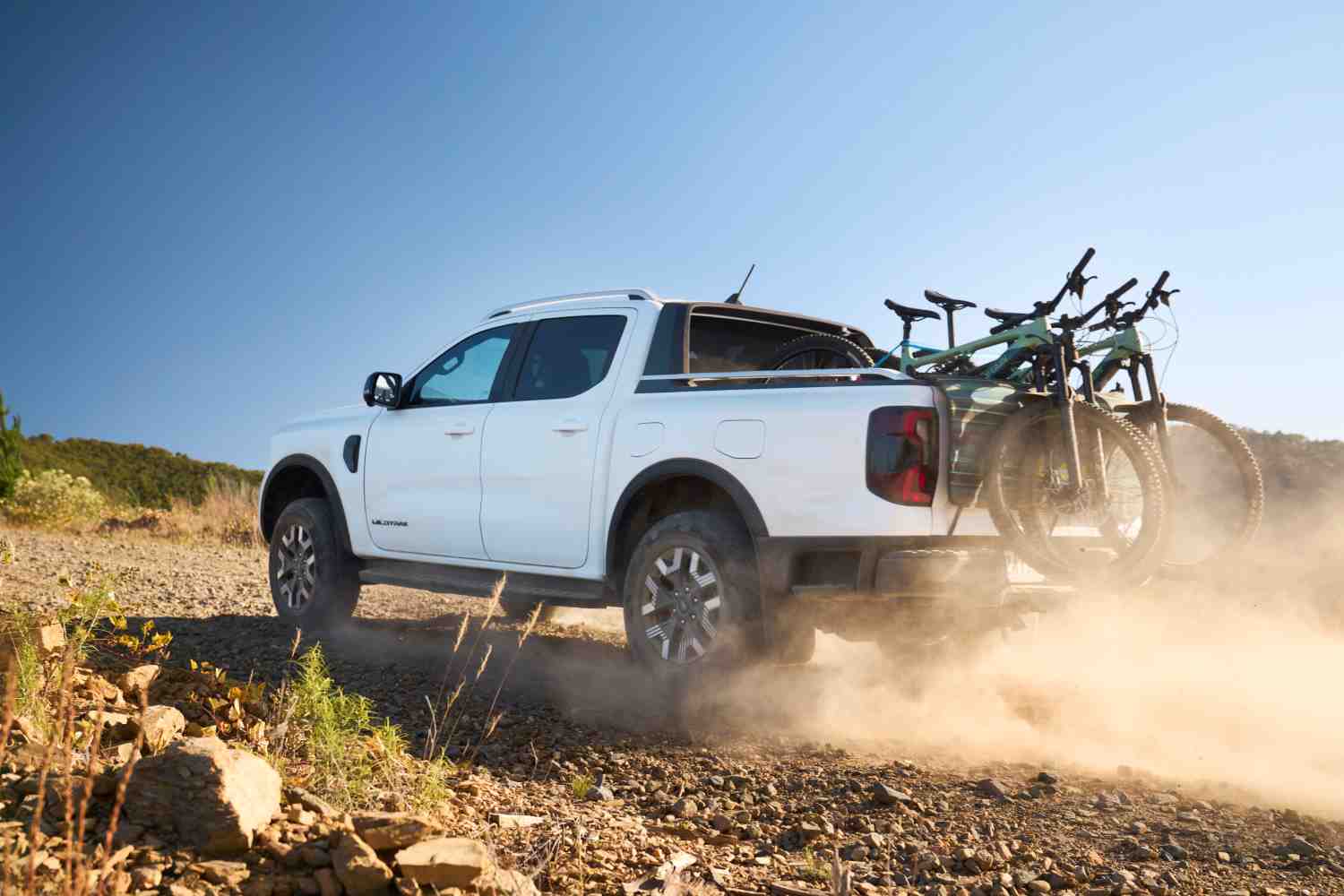
There are four driving modes, not all of which you’d find in a typical roadcar PHEV:
This range of options gives the vehicle flexibility and is not what you would see on the average roadcar hybrid, or even plug-in hybrid, which generally just have the equivalent of EV Now and EV Auto.
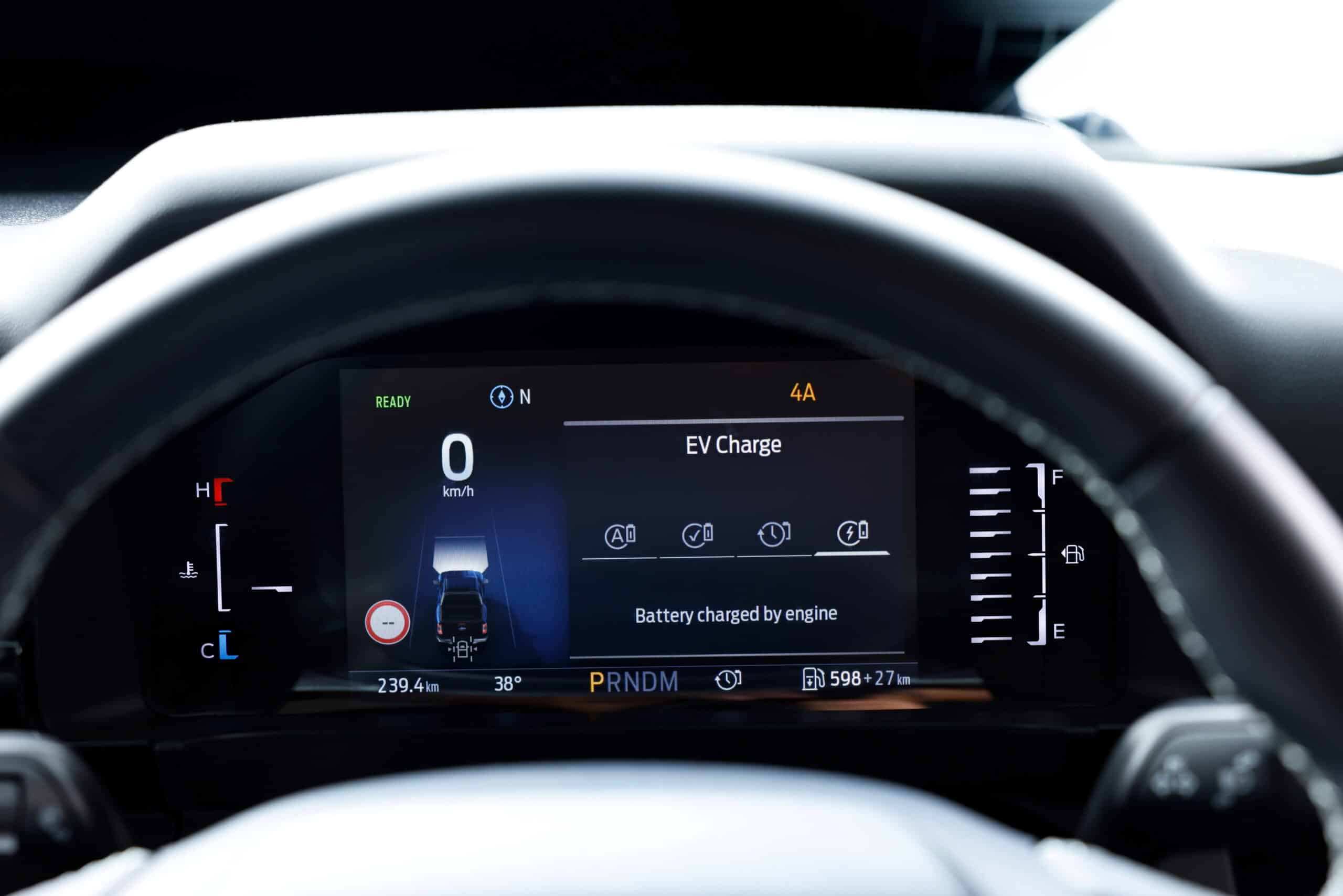
I started my drive in EV Now on pure electric power with 100% battery to see how the car would respond and how far I could drive it. And 26 km later, I had my answer when the battery indicator read 0% and the petrol motor kicked in. That’s a fair percentage short of the claimed 49km, but this vehicle did have all-terrain tyres as opposed to the EV-specific tyres fitted as standard, which would be lower rolling resistance, and a spare tyre.
Wait, what? Well, to keep weight down and payload up, spares are no-cost options for most of the range. That said, I can’t see the car getting to 49km in normal driving, even with those tyres. I think 25 to 35km is more realistic for a stock vehicle, and drop that again if you start adding mods. The 49km is based on the standard NEDC cycle, which is known to be more optimistic than the newer WLTP standard.
Something else I learned, or really confirmed, is the lack of power in EV Now. The electric motor can produce 300Nm of torque, the same as my old Defender TD5, but only 75kW of power, which is even less than the old Landie. And that the e-motor doesn’t push the 2600kg+ Ranger along very fast, and indeed off the lights, you may well find yourself foot-to-the-floor. In which case, the vehicle will offer to engage the petrol motor for extra performance – Ford clearly realises the EV motor by itself isn’t enough.
Same deal for hills, not off-road hills, just normal steeper hills you’d find on any bitumen road. Once you get to 100km/h, the car will happily hold speed provided it’s flat, but EV Now is not your real EV driving experience of oh-my-god acceleration and best kept for suburban driving below 60km/h.
Charging is AC only, which means slow. It’s around 7 hours off 10A, 4 from 15A. No fast DC charging here, as is usual with small batteries, but it does mean PHEVs with larger batteries can charge their batteries quicker than the Ranger.
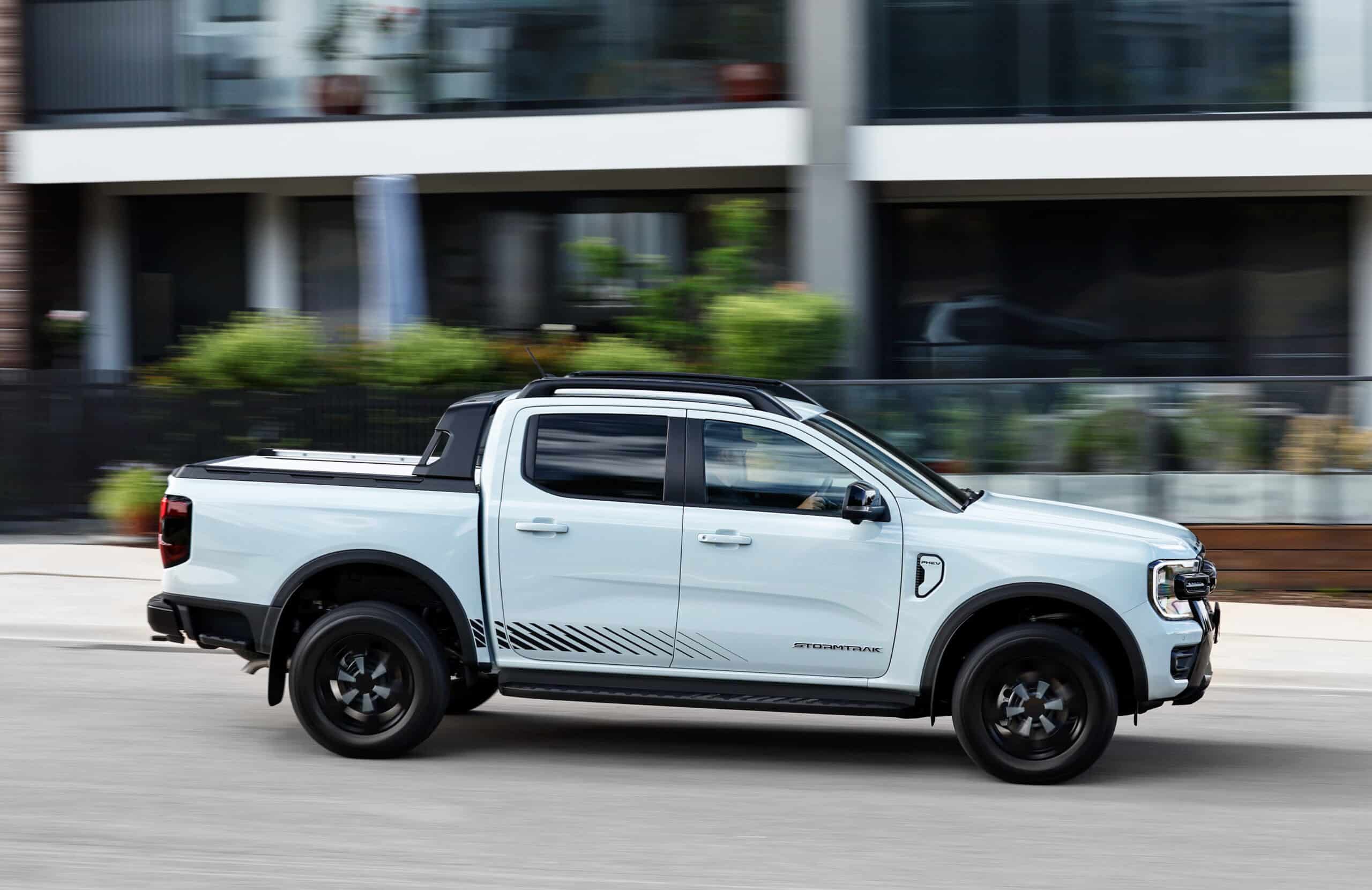
In EV Auto, the experience changes as now you have a petrol motor working in concert with the electric, and it’s pretty much the same acceleration and experience as a V6 Ranger. But wait, it’s more powerful than the V6! Yes, but the PHEV is heavier, so the power-to-weight is the same and therefore the acceleration is the same.
Handling is not quite as good as there’s 300+ extra kilos above the back axle, but it’s a Ranger, so even so, it still handles and rides very well. Ford has fitted their excellent AWD system, so no need to drive around in rear-drive only, just leave it in 4A – no, there is no fuel consumption benefit between 2H and 4A that you’ll find outside of a laboratory.
EV Auto definitely improves fuel consumption compared to not having an electric motor, and the slower you go, the greater the benefit. In stop/start traffic, the car will just use electric mode, and in cruise, it will disconnect the petrol when it can. It will recover energy through regen when you slow down, and there’s a braking coach to help you max out regen – pretty easy, just avoid using the friction brakes. It is also a more pleasant driving experience than the V6, same power but more refinement and quieter, whether you’re in traffic or in cruise.
We also got the chance to do some off-roading, and essentially, the PHEV has the same capability as any other Ranger. You get low range, 800mm wading, HDC, same clearances and the rear locker. But there are differences.
First off, the 2.3L petrol doesn’t give the same engine braking as the diesels, although it’s still enough. Some say that engine braking is no longer important now that we have HDC, but those people do not understand 4×4 driving. On the plus side is 4H in EV-Now, which is just amazing, and I absolutely love it.
Normally, you’d drive a 4×4 with low range in low range once the speeds drop below about 30km/h. You do this because the engine needs to spin up to say 1500-2000rpm to deliver useful torque, and that means if you’re wanting to crawl at say 1-5km/h over an obstacle, the torque converter has to slow things down quite a bit, which creates stress and heat. Hence, low range is a thing, which also means thanks to the magic of gearing, you now need only say 1100rpm as the gears multiply the torque.

With electric drive, that equation changes for the better. You have instant torque off idle, no need to rev up, and it’s very direct and precise. The result? Listen carefully – you should drive the PHEV Ranger in 4H EV mode instead of low range unless there are steep hills such that you need the benefit of engine braking.
Because guess what, this thing can climb. We did a 60% (31 degrees) in 4H EV at a slow, slow crawl. There was plenty of power and torque left in the car, I can tell you. No way would you attempt that in 4H in a diesel; it’d be vehicular abuse. Now I would still ascend in 4low because if you need to back down, you want the security and control of low range, but this thing will climb very well in 4H EV Mode, and I absolutely love it. And being an EV, you get to hear each tyre do its thing, which as a driver is an information source you don’t normally get. And by the way, it’s the same on a racetrack.
Caravan towers now have a choice. The PHEV will tow just as nicely as the V6, which is agreed to be the best towing ute in its class. You can ditch your generator and get away with a lot less lithium power and solar than you would otherwise specify, because you can just plug the car in. That maths should be considered if you’re ‘vanner and it can make a PHEV look financially attractive.
And once at your caravan site, you can drive into and around the park in EV mode, including parking. Charge the PHEV overnight at your site, and run into town next morning, and back, on pure EV mode. If it rains for four days straight… who cares, you’ve got 900ah of battery power at 12v for days and worst case just sit back in your van, touch your phone, start the car remotely and have it recharge its batteries.
Ford say the car is designed to idle as a generator, so kick back and watch it magic up some amp-hours for you. I really can see advantages for PHEV caravan owners, and I’m sure a long-range tank will be offered soon, so you’ll get decent range.
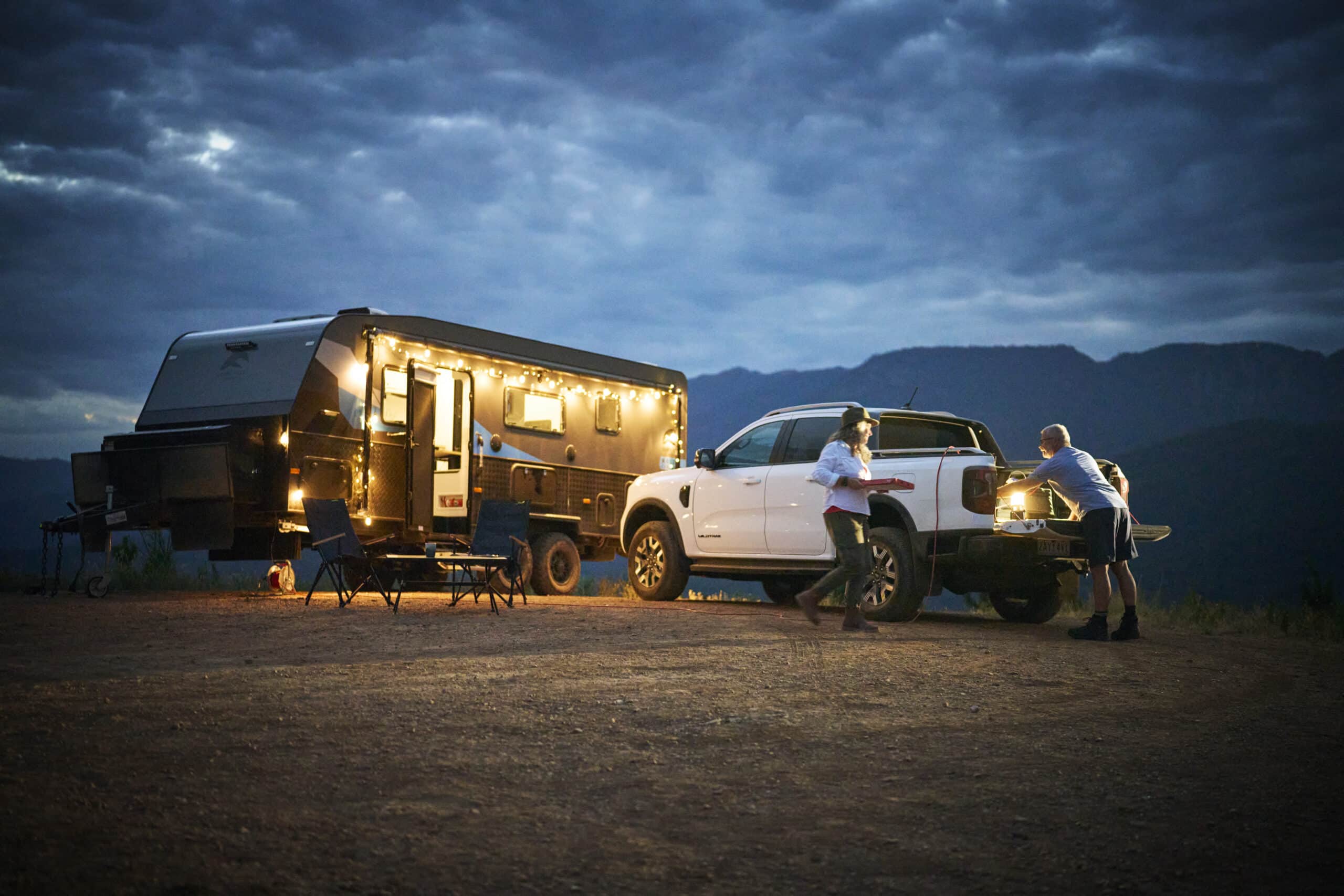
So what about Ranger V6 vs PHEV? No ‘best’, just different. The V6 offers more payload, rear axle load capacity, same power-to-weight, longer range, is cheaper, and you can easily fit a service body with trundle drawers in between. Ford say not to fit a service body to the PHEV, but I’m sure it’ll be done, albeit at a cost. The PHEV is cheaper to run for very short trips and has onboard power. The PHEV also loses 25mm of tub height compared to the diesels, even if Ford has made the base a bit longer. The diesels all come with spare tyres, whereas for PHEVs, they are a no-cost option except for the range-topper Stormtrak.
Now let’s talk about the Shark, a series hybrid, which is more powerful, much faster, cheaper, and has over twice the electric range. I’m going to largely stick with my advice when I first reviewed the Shark, which is buy it unless you need Ranger’s advantages in capability, which are tow, payload and off-road. Bear in mind that the Shark is pretty capable off-road, more than enough for most people, and tows a maximum 2500kg very well as its tare weight is actually more than its max tow and it doesn’t hurt for grunt.
Now I said ‘largely’ and by that I mean practicality. The Ranger has four driving modes and can force-charge its battery to 90%, the Shark can’t, max 70% unless you use Wade mode. But even then, there’s more usable power from the Shark as it has a 30kWh battery. The Ranger can charge at idle when locked. The Shark can’t. The Ranger can tow with cruise control, the Shark can’t. You can use 100% of the Ranger’s battery, but the Shark won’t let you go below 15%, although that may be because the Ranger’s 0% isn’t really 0%. And so on.
Now, most of that can be fixed by software, but the point is that Ranger has all Ford’s know-how for practical utes, and BYD are still figuring things out. Off-road, I would put Ranger ahead for sure on the basis that it doesn’t seem to mind high-torque takeoffs, the option of low range, and has a rear locker, plus very effective hill descent control. That means the Ranger will go further, but it will also make medium tracks easy.
Now for the GWM Cannon Alpha. This is a parallel hybrid (not a series hybrid), so essentially the same concept as the Ranger; conventional petrol drive with electric added. The Cannon is better off-road than the Shark; has front and rear lockers, and the front and rear axle is locked by a shaft.
Better than Ranger? Possibly, certainly the front locker will be an advantage. Alpha has a longer electric range than even the Shark, and is still cheaper than Ranger. But again, payload is extremely poor at a tiny 685kg, and the spare lives in the tub. It can tow 3500kg but with that 685kg payload you’re not putting a heavy towball mass on the rear axle so that 3500kg is even more optimistic that usual for a ute, but GWM have their headline so I guess the marketing job is done. My guess is that with 300+ TBM you’re be right on rear axle limit, whereas Ranger has a more margin even if not as much as V6.
Like Ranger, Alpha’s battery is also over the rear axle, not ideal for modifications or handling – there’s your tradeoff between series and parallel powertrain architectures.
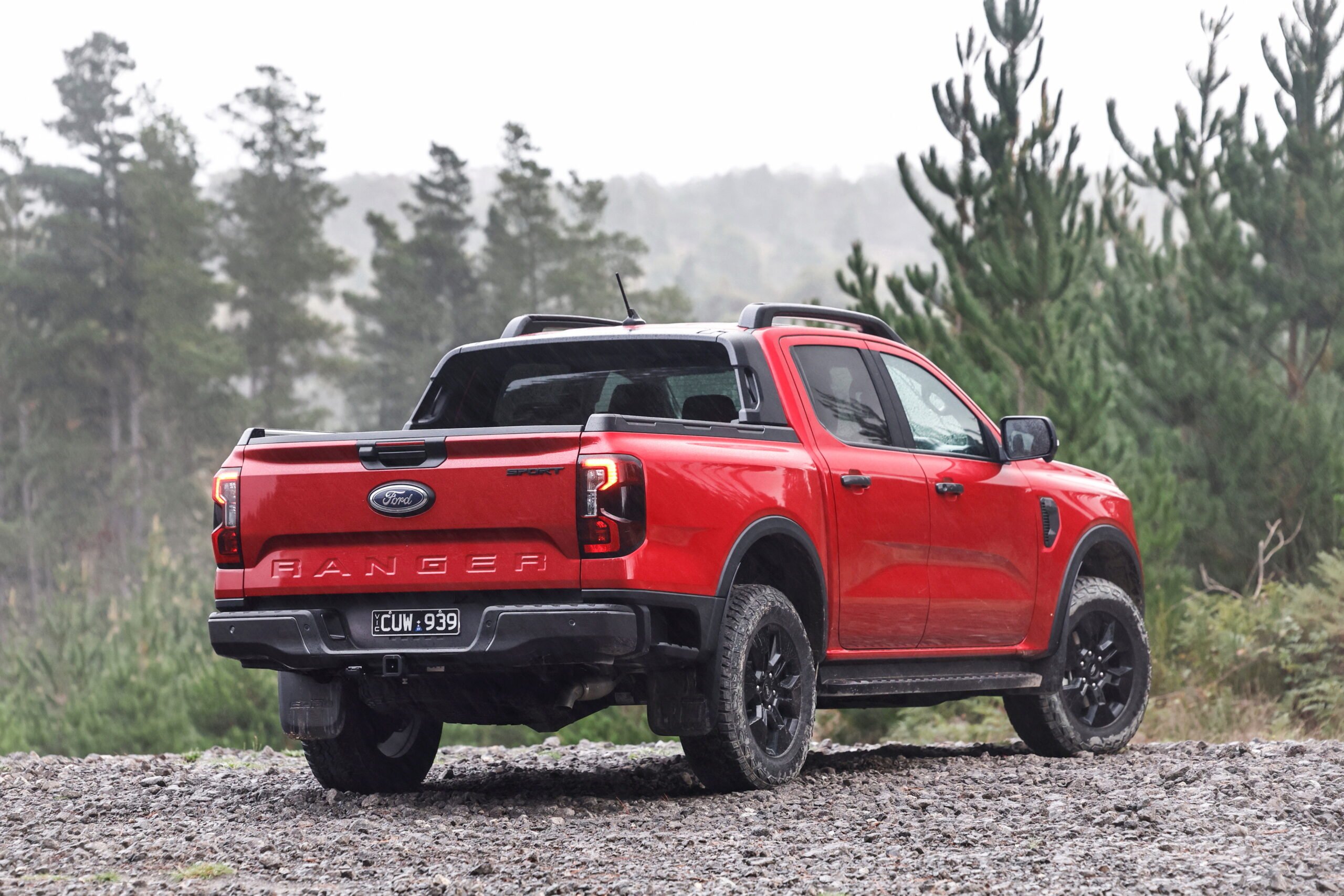
So, where does Ranger PHEV score against its two main competitors? Not on power, electric range, speed of charge, useable battery capacity at rest for powering things, or cost. Off-road its good, but even Shark is sufficient for many people, and Alpha is a step up from Shark.
Right now, I see the Ford Ranger PHEV having the best weight/payload/tow figures, and features such as you can lock it and have power, and I didn’t see any missteps, such as disabling cruise control when towing. Some of these advantages are software-only, and the Chinese have shown themselves to be quick responders, so anything that can be done or fixed by software probably will be.
The weights are important. It doesn’t matter how capable a vehicle is, or how cheap, if it can’t take a load, then it’s of limited use. This is the same criticism I have of the Quartermaster, Gladiator and other low-payload utes. I think load figures are Ranger’s biggest advantage over its competition. Generator mode is also great; I don’t think its competitors have been designed to idle for hours as a generator, or can deliver comparable the maximum power outputs from the battery.
All these vehicles are new, and there’s a lot of misinformation and agendas. We also haven’t fully figured out how to use them. Two examples from my life; driver training, where I’d love to be able to talk as a vehicle demonstrates without having a revving diesel to contend with. And trailer shuffling, I’d prefer to do that in EV mode rather than fire up the diesel just to swap trailers in parking places.
It would also be nice to simply not need to start a diesel engine for short trips, and as 4x4ers and towers, we actually do a lot of extremely short-range driving and idling. Even the other day when I was tensioning my winch rope…. could have done that in EV-mode, and I absolutely love the idea of carrying around 900ah+ of on-board power, who wouldn’t! But those are PHEV generic advantages, not specific to the Ranger PHEV, which faces a tough battle against its current competitors, let alone the future.
The Ranger PHEV value is beyond headline figures like 0-100km/h or EV range; it’s everything that made Ranger popular, with electric power. Whether that will be enough to sway the market is another question.